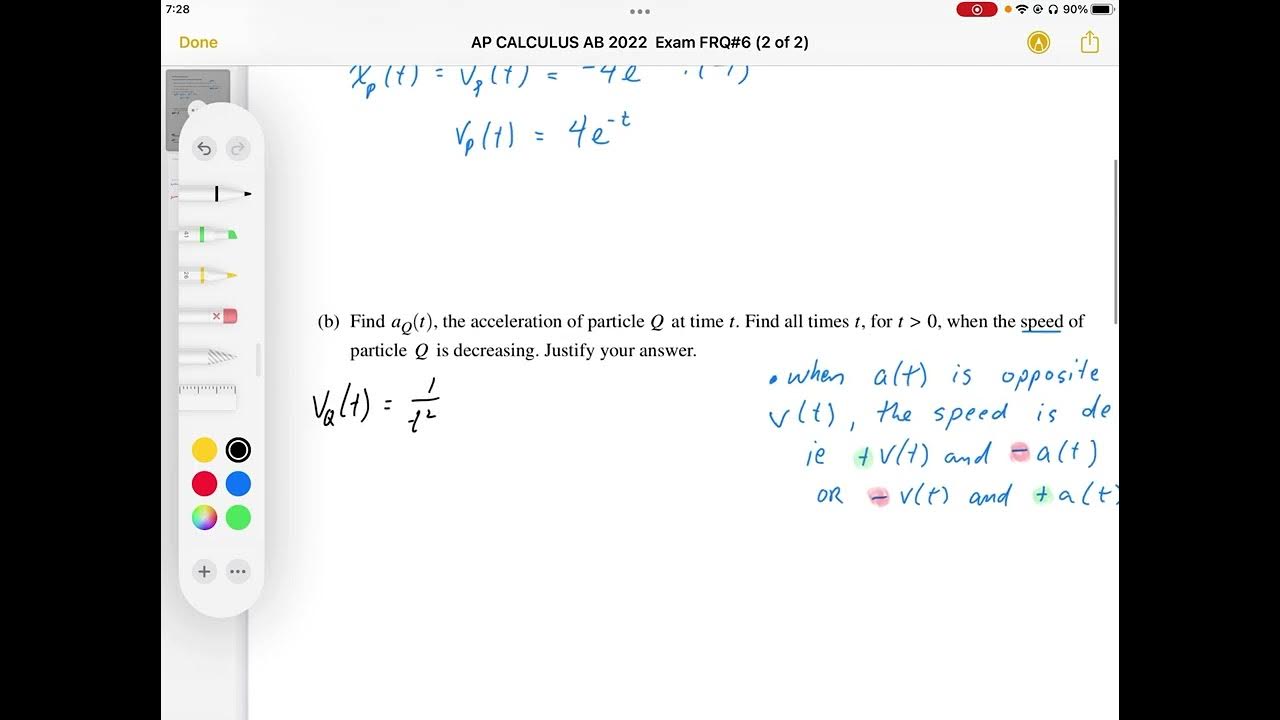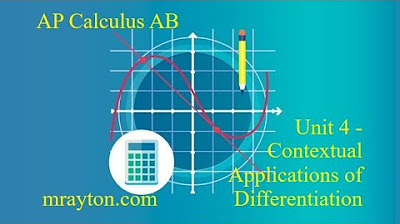2011 Calculus AB free response #1a | AP Calculus AB solved exams | AP Calculus AB | Khan Academy
TLDRThe video script discusses the motion of a particle along the x-axis, with a focus on determining whether the speed of the particle is increasing or decreasing at a specific time. It clarifies the difference between velocity (a vector quantity with magnitude and direction) and speed (a scalar quantity with only magnitude). The analysis involves calculating the acceleration at time t=5.5 and using it to infer the change in velocity. The conclusion is that while the velocity is decreasing, the speed is actually increasing due to the continuous negative velocity values becoming more negative, indicating a greater magnitude in the leftward direction.
Takeaways
- 📌 The problem involves a particle moving along the x-axis with given velocity and acceleration functions but without an explicit position function.
- 🔄 The velocity function v(t) is provided, and the acceleration a(t) can be derived as its derivative.
- 🏁 The initial position x(0) is given as 2, which is a key starting condition for the problem.
- ⏱ At time t=5.5, the question is about the increasing or decreasing of the particle's speed, not its velocity, emphasizing the difference between the two quantities.
- 🔢 Speed is a scalar quantity representing only magnitude, while velocity is a vector that includes both magnitude and direction.
- 📈 To determine if the speed is increasing or decreasing, one must first evaluate the acceleration at t=5.5, which is found to be negative, indicating a decrease in velocity.
- 🔄 The velocity at t=5.5 is calculated to be negative, which, combined with the negative acceleration, implies an increase in the magnitude of the velocity (speed) towards the left.
- 🤔 Two scenarios are considered: if the velocity is positive and decreasing, both velocity and speed decrease; if the velocity is negative and decreasing, the speed (magnitude) increases.
- 🧮 The use of a calculator is appropriate for solving this problem, as it involves complex exponential and trigonometric functions.
- 🎯 The final conclusion is that while the velocity is decreasing, the speed is actually increasing at t=5.5 due to the negative velocity becoming more negative over time.
Q & A
What is the given domain for the particle's motion?
-The domain for the particle's motion is from 0 to 6 seconds, as stated in the problem.
How is the position of the particle at the start defined?
-The position of the particle at the start (time t=0) is given as x(0) = 2.
What is the relationship between velocity and acceleration in this context?
-Acceleration is the derivative of velocity, which means it represents the rate of change of velocity over time.
How can you determine if the speed of the particle is increasing or decreasing at a given time?
-To determine if the speed is increasing or decreasing, one must first look at the acceleration, as it is the rate of change of velocity. Then, consider the initial velocity's sign and how the acceleration affects the speed's magnitude.
What is the significance of the difference between velocity and speed?
-Velocity is a vector quantity that includes both magnitude and direction, while speed is a scalar quantity that only considers magnitude. This distinction is important when analyzing the motion of the particle.
What is the acceleration function given in the problem?
-The acceleration function a(t) is given as (1/2) * e^(t/4) * cos(e^(t/4)).
How is the velocity function defined in the problem?
-The velocity function v(t) is defined as 2 * sin(e^(t/4)) + 1.
At time t=5.5, what is the calculated value of acceleration?
-At time t=5.5, the calculated value of acceleration is approximately -1.36, indicating that it is negative.
At time t=5.5, what is the calculated value of velocity?
-At time t=5.5, the calculated value of velocity is negative 0.45, indicating that the particle is moving to the left.
What can be concluded about the speed of the particle at time t=5.5 based on the given information?
-At time t=5.5, even though the velocity is decreasing, the speed of the particle is increasing because the magnitude of the negative velocity (leftward movement) is getting larger.
How does the initial velocity's sign affect the interpretation of speed and velocity at a given time?
-If the initial velocity is positive, a negative acceleration means both velocity and speed are decreasing. If the initial velocity is negative, a negative acceleration means the speed (magnitude of velocity) is increasing as the particle moves further in the negative direction.
Outlines
🌟 Understanding Velocity and Acceleration
This paragraph discusses the problem of a particle moving along the x-axis, with given velocity and acceleration functions but an unspecified position function. It emphasizes the difference between velocity (a vector quantity with magnitude and direction) and speed (a scalar quantity with only magnitude). The problem asks whether the speed of the particle is increasing or decreasing at time t=5.5. The solution involves analyzing the acceleration function, which is the rate of change of velocity, and determining its sign at t=5.5 to infer about the velocity's change. The paragraph clarifies that a negative acceleration indicates a decrease in velocity but also introduces the concept that if the velocity is negative (moving leftward), a decrease in velocity means an increase in speed (magnitude of velocity).
🔢 Evaluating Speed at a Specific Time
This paragraph continues the analysis by evaluating both the acceleration and velocity of the particle at time t=5.5. It provides a step-by-step calculation of the acceleration, resulting in a negative value, indicating that the velocity is decreasing. The paragraph then evaluates the velocity at t=5.5, finding it to be negative, which means the particle is moving leftward. The conclusion is that since the velocity is negative and decreasing, the speed (magnitude of velocity) is actually increasing because the particle is moving further in the leftward direction. The paragraph provides a clear methodology for determining whether speed is increasing or decreasing by first checking the sign of acceleration and then the sign of velocity at the specific time.
Mindmap
Keywords
💡particle
💡velocity
💡speed
💡acceleration
💡derivative
💡position
💡scalar
💡vector
💡calculus
💡increase/decrease
💡time
Highlights
The problem involves a particle moving along the x-axis with a given velocity and acceleration function.
The particle's initial position at time t=0 is x=2.
Velocity is a vector quantity with both magnitude and direction, while speed is a scalar quantity with only magnitude.
The acceleration function is derived from the velocity function, which is a key concept in understanding changes in motion.
The question asks whether the speed of the particle is increasing or decreasing at a specific time, t=5.5.
The acceleration at time t=5.5 is calculated to be approximately -1.36, indicating the velocity is decreasing.
The concept of evaluating the velocity function at a specific time to determine the direction of motion is crucial.
The velocity at time t=5.5 is found to be negative, which means the particle is moving in the leftward direction.
The scenario where velocity is negative and decreasing leads to an increase in speed, which is the magnitude of velocity.
The problem illustrates the nuanced relationship between velocity and speed, where a decrease in velocity does not necessarily mean a decrease in speed.
The use of calculus, specifically differentiation, is essential in analyzing the motion of the particle.
The problem demonstrates the application of mathematical functions in modeling real-world physical phenomena.
The evaluation of the velocity and acceleration functions at a specific time is a common technique in physics problems.
The problem highlights the importance of understanding the difference between vector and scalar quantities in physics.
The process of solving the problem involves a step-by-step approach, first evaluating acceleration and then velocity.
The final conclusion that the speed is increasing despite the velocity decreasing showcases the complexity of physical motion.
Transcripts
Browse More Related Video

Worked example: Motion problems with derivatives | AP Calculus AB | Khan Academy

AP CALCULUS AB 2022 Exam Full Solution FRQ#6(a,b)

AP Calculus AB - Straight Line Motion

What Are Speed and Velocity? | Physics in Motion

Velocity and speed: Motion in One Dimension

Changing Velocity | Forces & Motion | Physics | FuseSchool
5.0 / 5 (0 votes)
Thanks for rating: